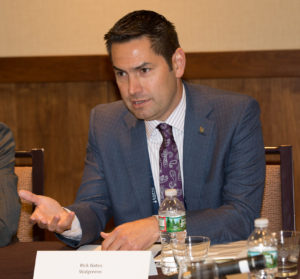MMR’s Seven Executives Who Made a Difference
DEERFIELD, Ill. — Rick Gates developed a passion for retail pharmacy early on, when he worked at an independent drug store in Des Moines while attending high school. Now, as vice president of pharmacy operations at Walgreen Co., Gates is making it possible for his fellow pharmacists to indulge the same passion by helping create the conditions in which they can practice at the top of their license and maximize their impact on patient care.

Rick Gates
“Our goal is to utilize the full potential of our pharmacists and allow them to have meaningful patient interactions and improve health outcomes,” he says. “The community pharmacist is ideally positioned to help solve the challenges now facing the health care system.”
Gates’ commitment to carving out an expanded role for retail pharmacy and his success in executing against that vision have earned him a place as one of MMR’s People Who Made a Difference in 2016.
As he and his colleagues work to bring new energy and new ideas to Walgreens’ pharmacy business, Gates is guided by firsthand experience. He joined the company after graduating with a pharmacy degree from the University of Iowa in 1995, and he was involved in direct patient care for almost eight years. He then took a series of positions at corporate headquarters, including manager of pharmacy operations optimization; director of centralization services for pharmacy; leader of pharmacy integration following Walgreens’ acquisition of Duane Reade in 2009; executive pharmacy director for 1,500 stores in the western U.S.; and divisional vice president of health and wellness initiatives, before moving into his current role.
“One of the great things within the Walgreens ecosystem is that there are a lots of different opportunities to use your skills to really challenge the status quo and do things differently,” notes Gates. “I got to run a kind of innovation wing back when we were getting out of the mind-set of relying on new store openings to drive growth and started to think about what’s next for community pharmacy and what’s next for the company.”
The orientation to the drug store business that Gates developed at that time continues to guide his thinking. One of the projects that he worked on was centralizing the filling of prescriptions in order to free store-level pharmacists to spend more time with patients.
Although Walgreens has since revised that approach, it continues to centralize certain other functions to achieve the same objective.
“It’s more centralization of some of the work flow, such as data entry and review,” Gates says. “The goal is to free up more of our pharmacists’ time in the stores so that they can better care for patients. There are multiple ways that we take labor out of the stores, and in the end both patients and our pharmacists benefit.”
The means may vary, but the objective is the same — make Walgreens pharmacies run as efficiently as possible in order to ensure a high degree of customer satisfaction and allow pharmacists to spend more of their time interacting with customers. The strategy is ideally suited to a time when members of the profession are eager to do more than dispense medications.
“Look at the scope of practice changes that have recently happened in states like Oregon and California, things like pharmacists being able to dispense birth control based off of a different protocol that’s been set up there,” Gates says.
“While this is something we’re still evaluating as a company in terms of participation, our pharmacists are eager to step into these types of roles when the right opportunities arise. As a company we are exploring ways to respond to those changes without impacting all of the other customer-based services we are providing.
“At Walgreens what we’re trying to do is leverage our current infrastructure to enable our pharmacists to do more of these patient care services. We have the ability to flex up and down based off of the needs of the particular patient population that we’re trying to serve.”
Citing the boom in immunizations for influenza and other conditions that has occurred at retail in recent years (Walgreens pharmacists administered approximately 7 million flu shots in fiscal year 2015), Gates predicts additional gains for the profession — and additional benefits for the nation’s health care system.
“Immunizations are a great example of how retail pharmacists can help offset some of the capacity issues that exist within the health care system,” he says. “That’s just one reason securing federal provider status [for pharmacists under Medicaid] is something that is talked about. More and more people, both inside and outside the profession, are comfortable with pharmacists providing services that go beyond just filling a prescription and offering advice.”




You must be logged in to post a comment Login